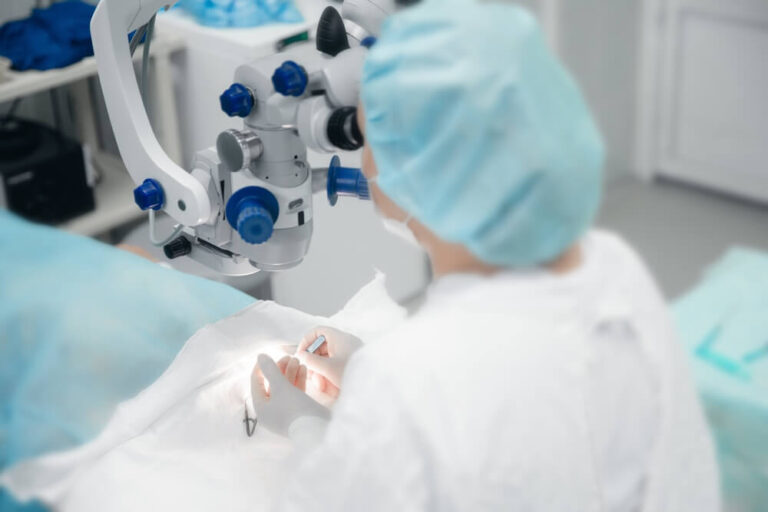Clear Lens Exchange (CLE) is essentially cataract surgery performed before a cataract has fully matured, offering significant advantages for patients over 40 who are beginning to experience vision problems. Instead of waiting for cataracts to develop and progress, which could take decades, opting for Clear Lens Exchange now can provide a variety of benefits, including the potential for improved vision, faster recovery, and cost savings. At Alvarado Eye Associates in San Diego, Dr. Lee Katzman has helped thousands of patients experience the life-changing benefits of CLE. In this article, we’ll explore why getting Clear Lens Exchange NOW could be a smarter choice than waiting for traditional cataract surgery later in life.

What is Clear Lens Exchange, and How Does it Compare to Cataract Surgery?
Clear Lens Exchange (CLE) is a procedure where the natural lens of the eye is replaced with an intraocular lens (IOL) to correct refractive vision errors, including nearsightedness, farsightedness, and presbyopia (age-related near vision loss). It’s a surgery performed when cataracts have not yet developed or matured, but when the eye’s natural lens shows signs of aging and deteriorating function. The key difference between CLE and traditional cataract surgery is that CLE is performed as a preventive measure. In contrast, cataract surgery only occurs once the natural lens has clouded enough to impair vision significantly.
Cataract surgery is often considered once the cataracts have reached a point where vision is impaired enough to affect what the insurance companies call “activities of daily living”. While both surgeries involve removing the natural lens and replacing it with an IOL, the decision to undergo CLE now versus waiting for cataract surgery when cataracts are present has important implications for your long-term vision health and wallet.
Understanding the Role of Refractive Lens Exchange (RLE) in Vision Correction
Refractive Lens Exchange (RLE), which is often used interchangeably with Clear Lens Exchange (CLE), follows the same surgical approach but emphasizes the procedure’s refractive benefits. While CLE highlights the preventive nature of the surgery in relation to cataracts, RLE places focus on the correction of significant refractive errors—especially in patients who are not ideal candidates for LASIK or PRK. With RLE, patients can achieve lasting vision correction for conditions like severe nearsightedness, farsightedness, and presbyopia by proactively replacing the aging natural lens with a premium intraocular lens. This dual benefit of visual enhancement and cataract prevention makes RLE an appealing long-term solution for those looking to reduce their dependence on glasses or contact lenses.
Cost Considerations: Doing It Now vs. Later
One of the main reasons many individuals delay or avoid cataract surgery is the perceived cost. Many assume that waiting for cataracts to form will allow them to take advantage of insurance coverage for cataract surgery, which typically covers the basic procedure with standard monofocal lenses. However, the full financial picture can be more complex, especially when considering long-term costs.
Opting for Clear Lens Exchange now may appear more expensive at first glance, but it can save you money in the long run. While insurance may cover part of the cost of traditional cataract surgery in the future, you will still be left with out-of-pocket expenses for advanced lenses (such as multifocal or toric lenses) or any additional technologies used in the procedure (such as laser or robotic assisted surgery). When I review the different out of pocket costs for a patient considering waiting 5 or 10 years for cataract surgery with insurance assistance, versus just paying for the entire procedure out of pocket, the difference only ends up being on the order of a few thousand dollars per eye. The question then becomes, is it worth it to fix your eyes NOW for a few thousand dollars more than it may cost you in 10 years?? Additionally, the cost of cataract surgery in 10 years is likely to rise due to inflation and other market pressures, making it more expensive than if you had undergone CLE now.
Furthermore, waiting for cataract surgery may not be as cost-effective as it seems due to long waitlists and potential insurance limitations. Many hospital systems in San Diego face long wait times for cataract surgery, many on the order of 9 months to a year from the time you are diagnosed to the date of your actual surgery. Because the baby boomers are coming of age for cataract surgery, and because the same population is retiring from the physician workforce, the supply is very low (of surgeons) and the demand is very high (many patients). This will be a compounding problem over the next 15 years, and you will see it extend into other facets of healthcare as well. It is very common for me to see patients in consultation that have legitimate cataracts, that need surgery, but come to me to simply avoid a 9-12 month wait at their hospital system (UCSD, KAISER, SHARP, SCRIPPS).
Insurance coverage can be a complex matter to deal with as well: Hospital systems have been dropping insurance plans (blue cross and SCRIPPS, for example) and dropping medicare advantage plans (also SCRIPPS), forcing patients to abandon their regular doctors to search for new doctors that may have less experience. Deductibles and copays have been rising, and costs of surgery without medicare secondaries are additional considerations. It’s just not as simple to think you can wait for cataract surgery in 10 years and have “everything covered”.
If the above explanation isn’t a good enough argument to proceed with CLE now, consider the cost savings for prescription glasses. Depending on the premium options selected for surgery, you may not need buy prescription glasses for the rest of your life! Even sunglasses can be selected right off of the shelf without further modification. This is a considerable cost savings!
Factors to Consider in the Cost of Clear Lens Exchange Now vs. Later
- Advanced Lens Options: Choosing premium lenses like light adjustable, multifocal or toric lenses today ensures you’re investing in improved vision without needing glasses.
- Insurance Coverage: While insurance may cover basic cataract surgery later, you’ll still face out-of-pocket expenses for specialized lenses or technologies, which are often required for optimal results.
- Surgical Technology: Although robotic femtosecond laser technology and other advanced surgical tools used during CLE might not be covered by insurance, they provide long-term benefits by improving the precision and outcomes of surgery, and make the surgery safer.
- Longer Wait Times: Waiting for cataract surgery often means dealing with extended waiting lists and a delayed improvement in vision.
- Rising Costs: Healthcare inflation and rising costs for cataract surgery in the future make it likely that waiting will only result in higher prices for the procedure.
Convenience and Faster Recovery
Waiting for traditional cataract surgery can sometimes mean dealing with longer delays, depending on where you live and your healthcare provider’s schedule. Many hospitals and surgical centers have long waitlists for cataract surgery, especially in areas with high demand for ophthalmologic services. If you are experiencing symptoms of cataracts, such as blurry vision, glare, or difficulty with night driving, the wait for surgery can feel even more frustrating.
Additionally, the recovery time for cataract surgery can be longer as you age. As the body’s ability to heal decreases, older patients may face extended recovery periods after surgery, including a higher risk of complications. Choosing to undergo Clear Lens Exchange when you are still in good health before cataracts begin to form, can result in a quicker recovery and fewer complications. Because CLE is performed as a preventive measure, removing the same structure in the eye that becomes a cataract later in life, the procedure is often more straightforward, with patients experiencing a faster and smoother healing process than those undergoing cataract surgery later in life.
Why Waiting for Cataract Surgery Can Be a Risky Choice
While cataract surgery is typically safe and effective, waiting until cataracts are well-advanced can sometimes result in a more complicated procedure. As cataracts develop, the eye’s natural lens becomes clouded, and removing it may become more complex. Additionally, as you age, other health conditions may develop, increasing the risk of complications during surgery and extending recovery time.
Moreover, some insurance providers may not approve cataract surgery immediately, even if you are experiencing vision impairment. Cataract surgery is often not approved until your vision loss meets a certain threshold or significantly impairs your ability to perform daily activities. As a result, you could find yourself facing delays or being told that you are not yet eligible for surgery, even though your quality of life is being affected by worsening vision. Choosing Clear Lens Exchange proactively can avoid this issue and allow you to address your vision concerns without waiting for insurance approval or until the cataracts become more severe.

The Long-Term Benefits of Clear Lens Exchange
Choosing Clear Lens Exchange now offers several advantages for long-term eye health. By replacing the natural lens before cataracts form, patients can improve their vision using advanced intraocular lens options, such as light adjustable, multifocal, toric, and accommodating lenses. These lenses can help reduce or eliminate the need for glasses or contacts, providing a more permanent and versatile solution to vision problems. Additionally, since CLE is performed early, patients enjoy better long-term visual outcomes compared to those waiting for cataract surgery.
Another long-term benefit of opting for Clear Lens Exchange is that it addresses both the refractive errors and presbyopia associated with aging, potentially eliminating the need for reading glasses or bifocals. As people age, the need for vision correction at multiple distances becomes more pronounced, and CLE offers a comprehensive solution that addresses near, far, and intermediate vision.
Why Choose Clear Lens Exchange Today
While it’s natural to want to wait for traditional cataract surgery to be covered by insurance, Clear Lens Exchange offers a valuable, proactive solution for many people, especially those over 40. By undergoing CLE now, you can fix your vision NOW, save money, avoid the inconvenience of long waitlists, and experience quicker recovery times. Moreover, opting for CLE allows you to take advantage of advanced IOL options that will improve your vision for the rest of your life. At Alvarado Eye Associates, Dr. Lee Katzman is dedicated to helping you achieve optimal vision through personalized, cutting-edge treatments. Contact us today to schedule a consultation and discuss whether Clear Lens Exchange is right for you.



